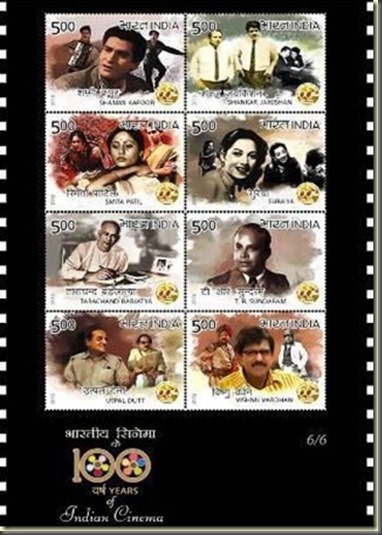Revenue stamps (sometimes also known as ‘fiscal’ stamps) were/are issued by various countries, counties, cities & municipalities to pay for various taxes and fees. Putting a revenue stamp on an article, receipt or document indicated that the appropriate fees had been paid (or in some cases to indicate that the item was tax or duty free).
Many people that collect postage stamps also collect revenue stamps. While many revenue stamps look like postage stamps, they are a totally separate category and generally have nothing to do with postage stamps as such (except in some countries, mostly British colonies, where stamps did double-duty and they are marked ‘Postage & Revenue’).
A revenue stamp is used to collect taxes or fees on documents, tobacco, alcoholic drinks, drugs and medicines, playing cards, hunting licenses, firearm registration, and many other items. A revenue or tax stamp or fiscal stamp is usually an adhesive label. Usually business establishments purchase these stamps from the government and attach them to taxed items as part of putting the items on sale; or for documents, as part of completing the form. Revenue stamps look like postage stamps and in some countries and at different times it has been possible to use postage stamps for revenue purposes.
The use of revenue stamps goes back earlier than that of postage stamps which were first used in 1840. The stamps used to implement the Stamp Acts of the 18th century were revenues. Their use became widespread in the 19th century, partly due to the success of the postage stamp and partly for streamlining government procedures. A revenue stamp present on a document or item indicated that the necessary fees for the item had already been paid. Revenue stamps are less frequently seen in the 21st century, as the rise of computerization has provided the ability to use numbers to track payments accurately.
There are a great many kinds of revenue stamps in the world issued by both national and local entities, and it is likely that many are still not recorded, especially of the Indian Princely States.
While revenue stamps sometimes look like postage stamps, they are intended for use on documents and taxed items like match boxes, cinema tickets, playing cards, etc., and are usually ‘cancelled’ by different methods. Some countries such as Great Britain have issued stamps valid for both postage and revenue, but this practice is now rare. Many different methods have been used to cancel revenue stamps, including pen or pencil marks, punching holes, perforation, inked hand stamps, embossing or simply tearing.
From around 1900, United States revenue stamps had to be mutilated by cutting, after being affixed to documents in addition to being cancelled in ink, and special ‘stamp mutilators’ became a part of office equipment.
Revenue stamps were once widely collected by philatelists and given the same status as postage stamps in stamp catalogs and at exhibitions. After World War I, however, they declined in popularity, may be because they were excluded from catalogues, as the number of postage stamps issued rose rapidly and the revenue stamps got crowded out. The nadir of revenue philately was during the middle years of the twentieth century. A Stanley Gibbons children's stamp album from the 1950s even warned in its introduction: ‘Since Philately is the collecting of stamps that are employed in connection with the Posts, do not put in your album fiscals, telegraph stamps, tobacco-tax labels and other such strange things as are often found in some collections.’ This definition of philately would not be recognised today. More recently, revenue philately has become popular again and now has its own FIP (Fédération Internationale de Philatélie) Commission and is an approved category in FIP endorsed stamp exhibitions.
Many catalogues have been issued by specialist publishers and dealers but it is true that revenue stamps are still not listed in some of the most popular catalogues, for instance the Stanley Gibbons and Michel catalogues, unless they are both revenue and postage stamps. However, both the standard Scott and the Scott Specialised United States catalogue feature US revenue stamps.
Some Types of Revenue Stamps According to the Duty Paid:
Court Fees
One of the earliest uses of revenue stamps was to pay Court Fees. Fiscal stamps were used in the Indian feudal states as early as 1797, almost 50 years before the first postal stamp, the Penny Black, appeared in 1840. Although India is only one of several countries that have used tax stamps on legal documents, it was one of the most prolific users. The process has its disadvantages due to the prevalence of forgeries, which costs the issuing government loss of revenue. Fig-1 shows a 1 anna Akalkot Court Fee stamp, mint. Mint stamps from Indian Princely states are rare.

Fig-1
Documents
The tax on documents, also commonly known as ‘stamp duty’, is one of the oldest uses of revenue stamps. Governments would enforce the payment of the tax by making unstamped documents not enforceable in court. The tax would apply to contracts, tenancy agreements, wills, etc. They could be in the form of stamp papers, embossed stamps, or adhesive stamps. Fig-2 shows an embossed revenue stamp on a cheque from the Princely State of Gwalior.
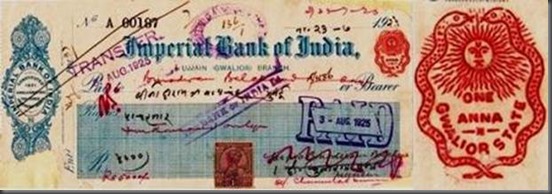
Fig-2
Receipts
Receipt stamps are revenue stamps which were used as acknowledgement of various payments. Fig-3 depicts1861 British India receipt stamp surcharged HALF ANNA on 1 anna, Fig-4 Proofs of Alwar KM Type 31 imperforate & Dewas Junior state revenue stamp and Fig-5 St. shows Vincent bisected 3d revenue stamp

Fig-3
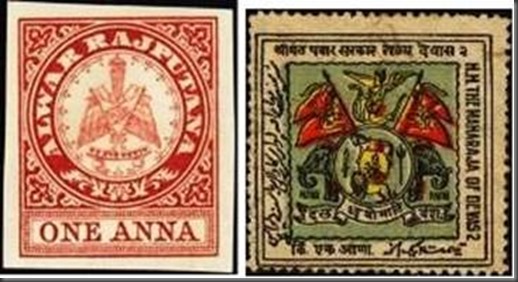
Fig-4
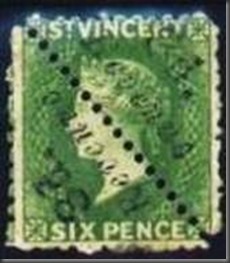
Fig-5
Tobacco and Alcohol
Tobacco and alcohol are taxed in many countries by the use of excise stamps. For instance, the producer may buy stamps from the government which are then affixed to each bottle of alcohol or packet of cigarettes, to show that tax has been paid. Often the stamp will be fixed across a seal so that on opening the pack or bottle the stamp is destroyed. Fig-6&7 show cigarette and wine tax stamps from U.S.A.

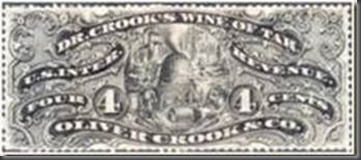
Fig-6 Fig-7
Sales Tax
Some articles that required sales tax to be paid had a pre-paid tax stamp affixed to them. Fig-8 shows a sales-tax stamp of value 9 cents from the state of Ohio, USA.
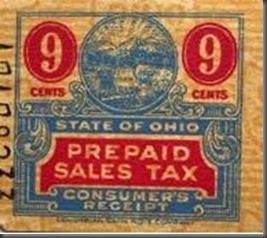
Fig-8
Entertainment Fee
Entertainment fees were levied on various forms of entertainment by affixing stamps on the tickets. Fig-9 shows ½ anna entertainment tax stamp of Pudukkottai State.
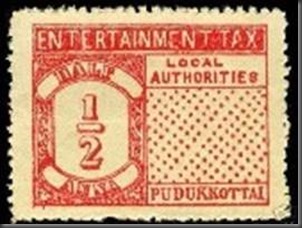
Fig-9
Motor Vehicle Fee
Motor Vehicle Fee stamps were issued by Indore state to collect taxes from motor vehicles. Fig-10 shows Motor Vehicle Fee stamp of Indore, value 100 rupees.
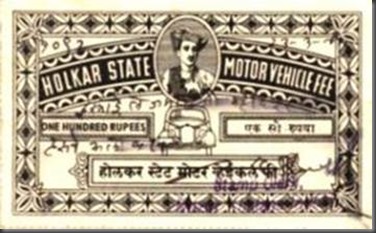
Fig-10
Telephone Service
Special stamps were issued for the telephone and telegraph services. Fig-11 shows a 3 annas Patiala State Telephone Service stamp.

Fig-11
Share Transfer
British India had special stamps that were required to be fixed to share certificates when they were transferred from one person to another. Fig-12 shows an 8-anna and Fig-13 shows a 1-rupee share transfer stamp.
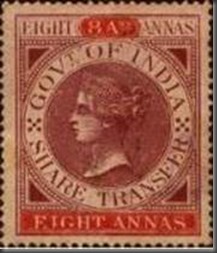

Fig-12 Fig-13
Insurance Stamp
Insurance policies have special insurance stamps fixed on to them. Fig-14 shows a pair of King George V 2-annas insurance stamps and Fig-15 a post-independence 500-rupee.
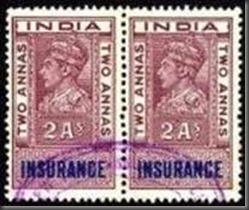

Fig-14 Fig-15
Special Types
Special types of revenue stamps were used in some Indian states. Sirmor used postal stationery with provisional overprint for court fees. Fig-16 shows Sirmor Postcard overprinted for use as 8-annas Court Fee.
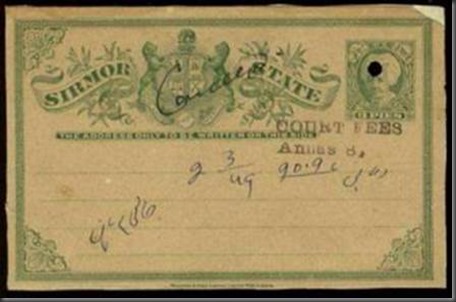
Fig-16
Stamped Papers
Collecting stamped papers is part of revenue philately. Stamped paper refers to a foolscap piece of paper that bears a pre-printed revenue stamp. Stamped papers have been used around the world to collect taxes on documents requiring stamping, such as leases, agreements, receipts, court documents and many others. The papers are bought blank apart from the pre-printed stamp and are available from stationers, lawyer’s offices, post offices and court stamp vendors according to local regulations. The matter to be recorded is then written or typed on to the stamped paper and it is lodged with the court or other interested party. This is an efficient way of collecting taxes and stamping documents without the need to submit them to a separate government stamp office.
The 1765 Stamp Act required all British colonies in the New World to use stamped paper prepared in London and embossed with a revenue stamp. This led to riots and political agitation which has been credited with sowing the seeds of the American Revolution.
Stamped paper was actually a Spanish invention and was introduced into India in 1848 following the introduction of the Congreve printing machine. Prior to this, legal documents were written on paper that could vary from strong parchment of good quality to ordinary stationers’ material. The use of water-marked paper came later. Prolific users of stamped paper have included Great Britain, the United States and India.

Fig-17
The stamp sometimes occupies the entire width of the top part of the paper and is often of an intricate engraved design in order to enhance security. The portrait of the ruling monarch was often part of the design. The paper frequently has a whole page watermark for the same reason. Figs-17&18 show British India King George V 12 Anna stamped paper used in 1938 & British India King George VI 150 rupees stamped paper used in 1943. Fig-19 shows 1934 5-rupee court fee stamp on 50 rupee Sangli State stamped paper and Figs-20&21 Bharatpur State 1anna stamp paper & Alipura State (India), stamped paper of 1900.

Fig-18

Fig-19


Fig-20 Fig-21
Collecting revenue stamps and stamped papers is an interesting and fun-filled hobby. While the stamps themselves are interesting, we find collecting them on the original document much more interesting. Especially fiscal stamps from the Princely States of India make colorful and interesting collections.
References
1. A Koeppel, R.D Manners, Court Fee and Revenue Stamps of the Princely States of India, Volume I – The Adhesive Stamps, Minneola, New York, 1983.
2. A Koeppel, R.D Manners, Court Fee and Revenue Stamps of the Princely States of India, Supplement to Volume I, Minneola, New York, 1986.
3. A Koeppel, R.D Manners, Court Fee and Revenue Stamps of the Princely States of India, Volume II – The Fiscal Stamp Paper, Minneola, New York, 1989.
4. Clive Akerman, The Presentation of Revenue Stamps: Taxes and Duties in South America. New edition. The Revenue Society of Great Britain, 2002.
5. Adolph Koeppel, The Stamps that Caused the American Revolution, the stamps of the 1765 British Stamp Act for America, American Revolution Bicentennial Commission, New York, 1976.
6. Einstein, Joseph; Thomas C. Kingsley and W. Richard DeKay. Handbook for United States Revenue Stamped Paper, American Revenue Association, Inc., United States.
7. SM Blatt, AM.Mollah, DH Heppell, Indian Government Fiscal and Judicial Stamps & Stamp Papers, Vol. 2, Part 1, 2004.
8. Jiří Černý, Revenue Stamps of the Princely States of India, 2009.
 : Col Jayanta Dutta & Dr Anjali Dutta
: Col Jayanta Dutta & Dr Anjali Dutta
email : doctorjayanta2009@gmail.com




























